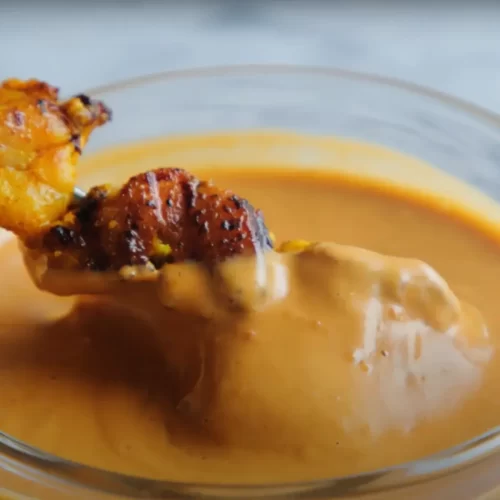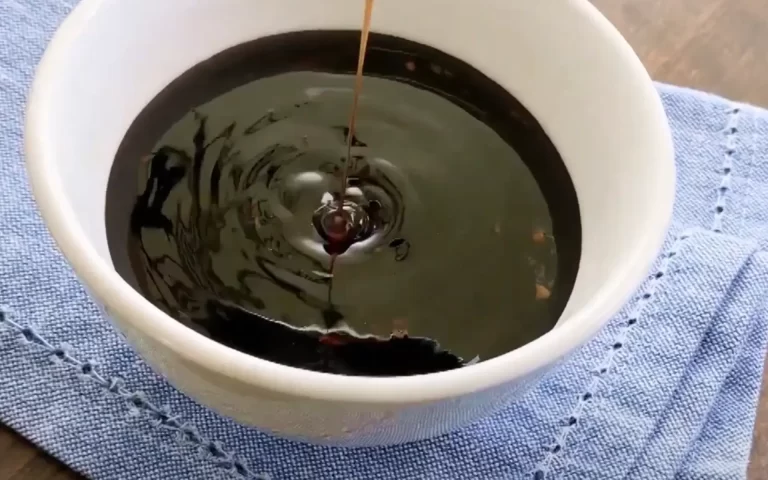Thai Peanut Sauce: The Complete Guide for this recipe
Thai Peanut Sauce, a cornerstone of Thai cuisine, entices with its bold blend of flavors—savory, sweet, spicy, and tangy. Originating from the bustling streets of Thailand, this versatile condiment has captivated taste buds worldwide. In this guide, we’ll delve into the intricacies of Thai Peanut Sauce, from its cultural roots to its diverse culinary applications.
Decoding Thai Peanut Sauce: From Street Food Staple to Global Sensation
A Taste of Tradition: Origins of Thai Peanut Sauce
Thai Peanut Sauce finds its genesis in the vibrant culinary landscape of Thailand, where street food vendors first concocted this delectable blend of peanuts, spices, and seasonings. With roots steeped in tradition, the sauce has evolved into a symbol of Thai gastronomy, celebrated for its bold flavors and aromatic profile.
Essential Ingredients: Crafting the Perfect Blend
At the heart of Thai Peanut Sauce lies a harmonious fusion of ingredients, each contributing to its distinct taste and texture. From creamy peanut butter and coconut milk to tangy lime juice and fiery chili peppers, the key to mastering this sauce lies in achieving the perfect balance of flavors.
The Art of Balancing Flavors: Sweet, Spicy, Sour, and Savory
Central to Thai cuisine is the delicate balance of flavors, and Thai Peanut Sauce is no exception. A symphony of sweet, spicy, sour, and savory notes dance on the palate, creating a sensory experience that is as complex as it is enticing.
Versatility in the Kitchen: Beyond Dipping and Dressing
While often associated with satay skewers and fresh spring rolls, Thai Peanut Sauce boasts versatility that extends far beyond traditional applications. From stir-fries and salads to marinades and glazes, the sauce adds depth and richness to a wide array of culinary creations.
Health Benefits: Nutritious and Delicious
In addition to its irresistible flavor, Thai Peanut Sauce offers a range of health benefits. Rich in protein, healthy fats, and essential nutrients, including vitamin E and niacin, this savory sauce provides both sustenance and satisfaction.
Homemade vs. Store-bought: Finding the Perfect Fit
While store-bought Thai Peanut Sauce offers convenience, crafting your batch allows for customization and control over ingredients. Whether opting for the simplicity of pre-made sauce or the creativity of homemade, there’s a perfect option for every palate.
Storing and Serving: Tips for Maximum Flavor
To preserve the freshness and flavor of Thai Peanut Sauce, proper storage is essential. Refrigerate homemade sauce in an airtight container for up to a week, or freeze for extended use. When ready to serve, allow the sauce to come to room temperature and stir well to recombine.
7 Mouthwatering Thai Peanut Sauce Recipes
1. Classic Thai Peanut Sauce
Embrace tradition with this classic Thai Peanut Sauce recipe. Combining creamy peanut butter, coconut milk, soy sauce, and a hint of spice, this versatile sauce is perfect for dipping, drizzling, or marinating.
2. Spicy Peanut Satay Sauce
Kick up the heat with Spicy Peanut Satay Sauce, a fiery twist on the traditional condiment. Infused with chili peppers, garlic, and ginger, this sauce adds a bold kick to grilled meats, tofu, or vegetables.
3. Coconut Curry Peanut Sauce
Transport your taste buds to the tropics with Coconut Curry Peanut Sauce. Creamy coconut milk, red curry paste, and aromatic spices come together to create a sauce that’s perfect for curries, stir-fries, and noodle dishes.
4. Peanut Sauce Noodles
Satisfy your cravings with Peanut Sauce Noodles, a simple yet satisfying dish that’s ready in minutes. Tossed with cooked noodles, fresh vegetables, and a generous dollop of peanut sauce, this recipe is sure to become a favorite.
5. Peanut Sauce Chicken Skewers
Impress guests with Peanut Sauce Chicken Skewers, a crowd-pleasing appetizer or main course. Marinated in a blend of Thai spices and coconut milk, these skewers are grilled to perfection and served with a side of tangy peanut sauce.
6. Thai Peanut Sauce Salad Dressing
Elevate your salads with Thai Peanut Sauce Salad Dressing, a creamy and flavorful alternative to traditional dressings. Drizzle over mixed greens, crunchy vegetables, and grilled chicken for a refreshing and satisfying meal.
7. Peanut Sauce Veggie Stir-fry
Whip up a quick and nutritious meal with Peanut Sauce Veggie Stir-fry, packed with colorful vegetables and protein-rich tofu. Served over a bed of steamed rice, this stir-fry is a wholesome and satisfying dinner option.

Thai Peanut Sauce:
Ingredients
- 1/4 cup peanut butter
- 2 tablespoons soy sauce
- 1 tablespoon lime juice
- 1 tablespoon honey or maple syrup
- 1 clove garlic minced
- 1 teaspoon grated ginger
- 1/4 teaspoon red pepper flakes optional
- 2-4 tablespoons water adjust for desired consistency
Instructions
- In a small bowl, whisk together peanut butter, soy sauce, lime juice, honey or maple syrup, minced garlic, grated ginger, and red pepper flakes.
- Gradually add water until you reach your desired consistency.
- Taste and adjust seasoning if needed.
- Serve as a dipping sauce for spring rolls, grilled chicken skewers, or toss with noodles and vegetables for a delicious peanut noodle dish.
FAQs: Answering Your Burning Questions
- Can I use almond butter instead of peanut butter in Thai Peanut Sauce? Yes, almond butter can be substituted for peanut butter in Thai Peanut Sauce for a slightly different flavor profile. Adjust the seasoning to taste accordingly.
- Is it gluten-free? Yes, but it’s essential to check the labels of store-bought sauces for any hidden gluten-containing ingredients.
- How long does it last in the refrigerator? it can be stored in the refrigerator for up to one week in an airtight container. Alternatively, it can be frozen for longer storage.
- Can I make it ahead of time? Yes, it can be made ahead of time and stored in the refrigerator or freezer until ready to use. Allow the sauce to come to room temperature before serving.
- Is it spicy? The level of spiciness can vary depending on the amount of chili peppers or chili paste used in the recipe. Adjust the heat level to suit your preferences.





